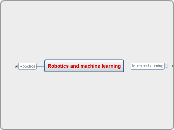Robotics and machine learning
Machine Learning
Types of learning
Rote learning
Learning by memorisation
Off by heart
Caching
Form of rote learning
Everything has to be stored
Impractical in a complex scenario
Learning from advice
Very broad and ill-defined concept
Difficult to transfer to machine learning
Learning from experience
Improves performance over time
'Evaluation Function' was assigned a weighting or ranking
Has led to the impressive success of genetic algorithms in some domains
Learning from examples (inductive learning)
System is provided with positive and negative examples
Uses these to make generalisations and form concepts
Winston's Arch
Aim was to see if a program could develop a representation of the concept of an "arch"
Neural nets (artificial neural systems)
Represented in the connection weights of a highly interconnected set of simple nodes
Follows three phases
Training
Validation
Application
Explanation-based learning
Uses a combination of a single example along with domain-related knowledge to explain the example
Requires a goal concept, and domain knowledge
Represented in a way which can be manipulated using deductive and inductive logic
Learning by discovery
Learning by analogy
Robotics
"Blocks world"
Number of blocks which can be piled on top of each other
Uses predicates, like Prolog
Example: ontable(b).
Planning
Find search techniques
Exhaustive searching
Heuristic searching
Industrial robotics
Vision systems
